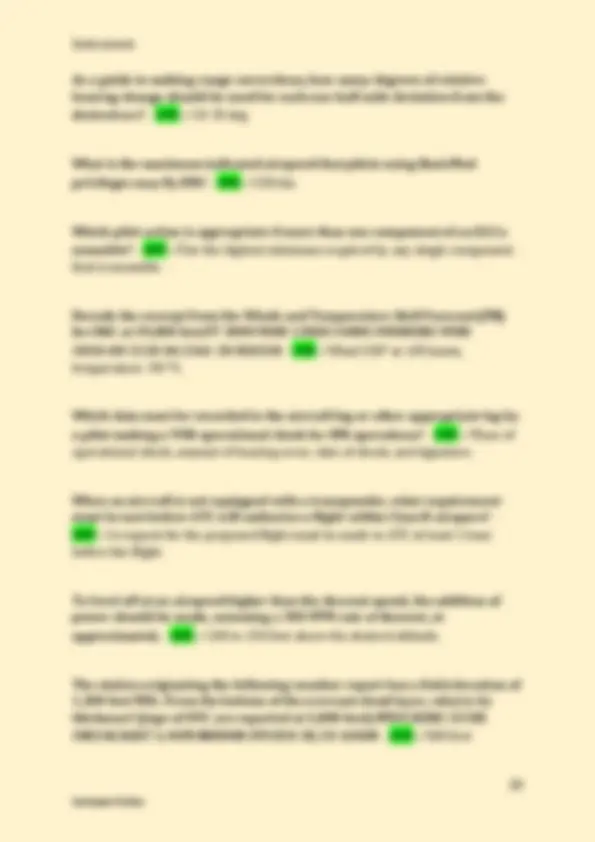




























Study with the several resources on Docsity

Earn points by helping other students or get them with a premium plan


Prepare for your exams
Study with the several resources on Docsity

Earn points to download
Earn points by helping other students or get them with a premium plan
Community
Ask the community for help and clear up your study doubts
Discover the best universities in your country according to Docsity users
Free resources
Download our free guides on studying techniques, anxiety management strategies, and thesis advice from Docsity tutors
what indications should you observe on the turn and slip indicator during taxi? - ANS ✓the ball moves freely opposite the turn, needle deflects in direction of turn what indication is presented by the miniature aircraft of the turn coordinator - ANS ✓indirect indication of the bank attitude The displacement of a turn coordinator during a coordinated turn will - ANS ✓increase as angle of bank increases What does the miniature aircraft of the turn coordinator directly display? - ANS ✓the indicator first shows the rate of banking and, once stabilized, the rate
Typology: Exams
1 / 34

This page cannot be seen from the preview
Don't miss anything!



























what indications should you observe on the turn and slip indicator during taxi? - ANS ✓the ball moves freely opposite the turn, needle deflects in direction of turn what indication is presented by the miniature aircraft of the turn coordinator - ANS ✓indirect indication of the bank attitude The displacement of a turn coordinator during a coordinated turn will - ANS ✓increase as angle of bank increases What does the miniature aircraft of the turn coordinator directly display? - ANS ✓the indicator first shows the rate of banking and, once stabilized, the rate of turn in a technologically advanced aircraft, the pilot sees the flight instruments on what? - ANS ✓The PFD you are flying an aircraft with an electronic flight display and the air data computer fails. What instrument is affected? - ANS ✓airspeed indicator During a skidding turn to the right, what is the relationship between the component of lift and centrifugal force? - ANS ✓centrifugal force is greater than horizontal lift and load factor is increased
when airspeed is increased in a turn, what must be done to maintain constant altitude? - ANS ✓increase bank or decrease AoA If a standard rate turn is maintained, how much time would be required to turn to the left from a heading of 090° to a heading of 300°? - ANS ✓ 50 seconds approximately what percent of the indicated vertical speed should be used to determine the number of feet to lead the level off from a climb to a specific altitude? - ANS ✓10 % conditions that determine pitch attitude to maintain level flight are - ANS ✓airspeed, density, wing design, AoA as a rule of thumb, attitude corrections of less than 100ft should be corrected by using - ANS ✓less than a full bar width on the attitude indicator. as a rule of thumb, altitude orrections of less than 100ft should be corrected by using a - ANS ✓half bar width on the attitude indicator. Approximately what percent of the indicated vertical speed should be used to determine the number of feet to level off from a climb? - ANS ✓10% Conditions that determine pitch attitude required to maintain level flight are - ANS ✓airspeed, air density, wing design, and angle of attack As a rule of thumb, altitude corrections of less than 100ft should be corrected by using - ANS ✓less than a full bar width on the attitude indicator As a rule of thumb, altitude corrections of less than 100 ft should be corrected by using a - ANS ✓half bar width on the attitude indicator
Which term describes the hydroplaning which occurs when an aircrafts tire is effectively held off a smooth runway surface by steam generated by friction? - ANS ✓Reverted rubber hydroplaning The greatest DME indication error between actual ground distance and displayed ground distance occurs at - ANS ✓high altitudes close to vortac As a rule of thumb, to minimize DME slant range error, how far from the facility should you be to consider the reading accurate? - ANS ✓one or more miles for each 1000ft of altitude above facility When flying directly over a published airborne VOR checkpoint, what is the maximum error allowed for IFR flight? - ANS ✓plus or minus 6 degrees of the designated radial When using VOT to make a VOR receiver check, the CDI should be centered and the OBS should indicate that the aircraft is on the - ANS ✓360 deg radial When making an airborne VOR check, what is the maximum allowable tolerance between the two indicators of a dual VOR? - ANS ✓4 degrees between the two indicated radials of a VOR When the CDI needle is centered during a airborne VOR check, te omni- bearing selector and the OBS indicator should read - ANS ✓within 6 deg of the selected radial While airborne, what is the maximum permissible variation between the two indicated bearings when checking one VOR system against the other? - ANS ✓4 deg between the two indicated bearings How should the pilot make a VOR receiver check when the aircraft is located on the designated checkpoint on the airport surface? - ANS ✓Set the
OBS on the designated radial. The CDI must center within plus or minus 4 deg of the radial with a from indication Where can a VOT frequency be found? - ANS ✓Only in the chart supplement Which indications are acceptable tolerances when checking both VOR recievers by using VOT? - ANS ✓176 deg TO and 003deg FROM respectively What indication should a pilotrecieve when a VOR station is undergoing maintenance and may be considered unreliable? - ANS ✓No coded ident, but possible navigation indications When a VOR/DME is collocated under frequency pairings and the VOR portion is inoperative, the DME identifier will repeat at an interval of - ANS ✓30 second intervals at 1350 Hz What is the meaning of a single coded ident recieved only once approximately every 30 seconds from a vortac? - ANS ✓The DME component is operative and the VOR is inop For operations off established airways at 17,000 feet MSL in the contiguous U.S., (H) Class VORTAC facilities used to define a direct route of flight should be no farther apart than - ANS ✓200NM You are planning an IFR flight off established airways below 18,000 ft. If you use a VOR nav to define the route, the maximum distance between navaids should be - ANS ✓80 NM An aircraft which is located 30 miles from a VOR station and shows a 1/ scale deflection on the CDI would be how far from the selected course centerline? - ANS ✓2 1/2 miles
Prior to using GPS waypoints for RNAV, what can you do to check the currents status of the GPS database? - ANS ✓Compare the GPS database to the enroute low altitude chart. If they are the same, the GPS database is current While conducting a GPS approach, if you disengage the auto sensitivity what will occur? - ANS ✓The approach mode annunciation will disengage GPS systems certified for IFR operations cannot be used as a substitute for DME recievers - ANS ✓in selecting an alternate that requires use of DME When using a TSO-C129 or TSC-C196 for navigation and instrument approaches, any required alternate airport must have - ANS ✓an approved operational instrument approach procedure other than GPS Your aircraft is equipped with WAAS. While performing a GPS approach you note an "LNAV+V available" indication. You know that - ANS ✓The indication reflects an artificially created advisory glide-path that you can use to descend to the LNAV MDA Aircraft operating under IFR with TSO-C129 or TSC-C196 for enroute navigation must also have installed - ANS ✓the avionics necessary to receive appropriate navaids along the route Which of the following terms describes an airport? - ANS ✓an area of land or water that is used or intended to be used for the landing and takeoff of aircraft, and includes its buildings and facilities, if any The glide path qualification surface (GQS) limits the height of obstructions between - ANS ✓decision altitude and the runway threshold
After your recent IFR experience lapses, how much time do you have before you must pass an instrument proficiency check to act as pilot in command under IFR? - ANS ✓6 months What minimum conditions are necessary for the instrument approaches required for IFR currency? - ANS ✓The approaches my be made in an aircraft, flight simulator, or flight training device An instrument rated pilot, who has not logged any instrument time in 1 year or more, cannot serve as pilot in command under IFR, unless the pilot - ANS ✓passes an instrument proficiency check in the category of aircraft involved, given by an FAA examiner, instrument instructor, or FAA inspector, Indication on magnetic compass when rolling into standard rate turn to the right from an easterly heading in the northern hemisphere? - ANS ✓approximate correct heading if turn is smooth. Indication of compass as you roll into standard rate turn to the right from a south heading in northern hemisphere? - ANS ✓Turn to the right but faster than normal If, while in level flight, it becomes necessary to use an alternate source of static pressure vented inside the airplane, which of the following should the pilot expect? - ANS ✓the altimeter will read higher than normal, airspeed greater than normal, vsi momentarily shows a climb You check the flight instruments while taxiing and find that the vertical speed indicator (VSI) indicates a descent of 100 feet per minute. In this case, you - ANS ✓may take off under ifr and use 100ft descent as the zero indication the local altimeter setting should be used by all pilots in a particular area, primarily to provide - ANS ✓better vertical separation of aircraft
when an aircraft is accelerated, some attitude indicators will incorrectly indicate a - ANS ✓climb During normal flight with a vacuum driven attitude indicator, control pressures should not normally move the horizon bar more than - ANS ✓one- half bar width, with not more than an additional one-half bar width for normal flight deviations Commercial pilot without an instrument rating is limited to - ANS ✓Flights less than 50NM an cant fly at night (for hire) Before beginning any flight under IFR, the pilot in command must become familiar with all available information concerning that flight including - ANS ✓the runway lengths at airports of intended use, and the aircrafts takeoff and landing data When may ATC request a detailed report on an emergency even though a rule has not been violated? - ANS ✓When priority has been given While on an IFR flight, a pilot has an emergency which causes a deviation from an ATC clearance. What action must be taken? - ANS ✓Notify ATC as soon as possible Which of the following is required equipment for operating an aircraft within class B? - ANS ✓A 4096 code transponder with automatic pressure altitude reporting equipment What are the alternate minimums for an airport with a precision approach procedure? - ANS ✓600 foot ceiling and 2 miles visibility
When a pilot elects to proceed to the selected alternate airport, which minimums apply for landing at the alternate? - ANS ✓The landing minimums for the approach to be used What minimum weather conditions must be forecast for your ETA at an alternate airport, that has only a VOR approach with standard alternate minimums, for the airport to be listed as an alternate on the IFR flight plan?
When are ATIS broadcasts updated? - ANS ✓Upon receipt of any official weather, regardless of content change or reported values What information is contained in the notices to airmen publication? - ANS ✓Current notams and FDC notams Which equipment determine the code for block 3 as a suffix to aircraft type for a flight plan form? - ANS ✓DME, Transponder, and RNAV What altitude do you put in for a flight plan form? - ANS ✓Altitude for first leg What is a waypoint when used for an IFR flight? - ANS ✓A predetermined geographical position used for an RNAV route or an RNAV instrument approach You may cancel an IFR flight plan - ANS ✓If VMC outside Class A airspace What information should be entered in the block "destination aerodrome" on a flight plan form? - ANS ✓The ICAO four letter identifier for the destination airport What response is expected when ATC issues an IFR clearance to pilots of airborne aircraft? - ANS ✓Read back those parts containing assignments or vectors and any part requiring verification Which clearance items are always given in an abbreviated IFR departure clearance? (Assume radar environment.) - ANS ✓Destination airport, altitude, DP name, Number, and/or transition, if appropriate Which information is always given in an abbreviated departure clearance? - ANS ✓Name of destination airport or specific fix and altitude.
What is the significance of an ATC clearance "Cruise six thousand"? - ANS ✓It authorizes the pilot to conduct a flight at any altitude from minimum IFR up to and including 6, A "cruise four thousand feet" clearance would mean that the pilot is authorized to - ANS ✓vacate 4,000ft without notifying ATC When should a pilot state their position on the airport when calling the tower for takeoff? - ANS ✓When departing from a runway intersection Which report should be made to ATC without a specific request when not in radar contact? - ANS ✓When leaving final approach fix inbound on final approach When ATC has not imposed any climb or descent restrictions and aircraft are within 1,000 feet of assigned altitude, pilots should attempt to both climb and descend at a rate of between - ANS ✓500 FPM and 1,500 FPM For IFR planning purposes, what are the compulsory reporting points when using VOR/DME or VORTAC fixes to define a direct route not on established airways? - ANS ✓Fixes selected to define the route During the en route phase of an IFR flight, the pilot is advised 'Radar service terminated.' What action is appropriate? - ANS ✓resume normal position reporting While on an IFR flight plan, you should notify ATC of a variation in speed when - ANS ✓average TAS changes 10 kts or 5% Which procedure should you follow if you experience two-way communication failure while holding at a fix with an EFC time? - ANS ✓Depart the holding fix at the EFC time
RVR minimums for landing are prescribed in an IAP, but RVR is inoperative and cannot be reported for the intended runway at the time. Which of the following would be an operational consideration? - ANS ✓RVR minimums which are specified in the procedures should be converted and applied as ground visibility If the pilot loses visual reference while circling to land from an instrument approach and ATC radar service is not available, the missed approach action should be to - ANS ✓make a climbing turn toward the landing runway and continue the turn until established on the missed approach coursePa Which of the following is true regarding parallel ils approaches? - ANS ✓Parallel ils approaches provide aircraft a minimum 1 1/2 miles seperation between successive aircraft If all ILS components are operating and the required visual references are not established, the missed approach should be initiated upon - ANS ✓arrival at the DH on the glide slope How does a pilot determine if DME is available on an ILS/LOC - ANS ✓IAP indicate DME/ TACAN channel in LOC frequency box Which pilot action is appropriate if more than one component of an ILS is unusable? - ANS ✓Use the highest minimum required by any single component that is usable Which substitution is appropriate during an ILS approach? - ANS ✓LOC minimums should be substituted for ILS minimums whenever the glide slope becomes inoperative Immediately after passing the final approach fix inbound during and ILS approach in IFR, the glide slope warning flag appears. The pilot is - ANS ✓permitted to continue the approach and descend to the localizer MDA
When installed with the ILS and specified in the approach procedures, DME may be used - ANS ✓in lieu of the OM When tracking inbound on the localizer, which of the following is the proper procedure regarding drift corrections? - ANS ✓Drift corrections should be accurately established before reaching the outer marker When flying a 3 degree glide slope, a constant tailwind shears to a calm wind. Which conditions should the pilot expect? - ANS ✓Airspeed and pitch attitude increase and there is a tendency to go above glide slope When cleared to execute a published sidestep maneuver for a specific approach and landing on the parallel runway, at what point is the pilot expected to commence this maneuver? - ANS ✓As soon as possible after the runway is in sight At what point should the timing begin for the first leg outbound in a nonstandard holding pattern? - ANS ✓When over or abeam the holding fix, whichever occurs later What timing procedure should be used when performing a holding pattern at a VOR? - ANS ✓timing for the outbound leg begins over or abeam the VOR, whichever occurs later To ensure proper airspace protection while holding at 5,000ft in a civil aircraft, what is the maximum airspeed a pilot should use? - ANS ✓200 kts When more than one circuit of the holding pattern is needed to lose altitude or become better established on course, the additional circuits can be made - ANS ✓only if the pilot advises ATC and ATC approves
An airport may not be qualified for alternate use if - ANS ✓the NAVAIDS used for the final approach are unmonitored During an instrument approach, under what conditions, if any, is the holding pattern course reversal not required? - ANS ✓when radar vectors are provided On a non precision approach, what is the maximum acceptable descent rate during the final stages of the approach? - ANS ✓1000 FPM When being radar vectored, an approach clearance is is received. The last assigned altitude should be maintained until - ANS ✓established on a segment of a published route or IAP Under the stabilized approach concept, what is the maximum acceptable descent rate during the final stages of an approach? - ANS ✓1000 FPM for either precision or non precision approaches When the approach procedure involves a procedure turn, the maximum speed should not be greater than - ANS ✓200 kts If the plan view on an instrument approach chart does not include a procedure turn barb, that means - ANS ✓a procedure turn is not authorized The instrument approach criteria for Category A airplane is based on a maximum airspeed of - ANS ✓90 knots Which is true regarding the use of an instrument departure procedure chart? - ANS ✓To use an instrument departure procedure the pilot must process at least the textual description of the approved procedure
Which clearance procedures may be issued by ATC without prior pilot request? - ANS ✓DP's, STAR's, and visual approaches Unless otherwise stated, instrument procedure use the standard IFR climb gradient - ANS ✓200 ft per NM On a GPS with WAAS capability, what is the significance of the LNAV+V being displayed? - ANS ✓Advisory vertical guidance is provided as an aid to the pilot during the descent to the runway When proper RAIM sensitivity is not availability is not available, manually resetting sensitivity to .3NM will - ANS ✓not automatically change the RAIM sensitivity on some receivers The correct GPS entry when ATC says "Expect the GPS approach" is - ANS ✓only load the approach During a WAAS GPS approach, you receive an LNAV+V annunciation on the GPS display. You should - ANS ✓descend the the LNAV approach minimums using the barometric altimeter to comply with altitude restrictions, referencing advisory vertical guidance as an aid When using GPS for navigation and instrument approaches, any required alternate airport must have - ANS ✓an approved operational instrument approach procedure other than GPS If you experience tunnel vision and cyanosis, you may have symptoms of - ANS ✓hypoxia Carbon monoxide poisoning, common in flying as a result of an exhaust leak, is considered what type of hypoxia? - ANS ✓hypemic